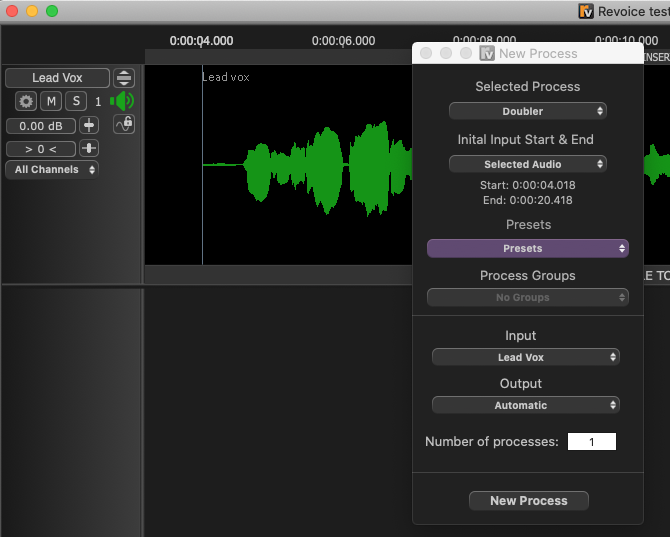Check/change Doubler settings
Let's start with a simple example session with one short mono audio signal ("Lead vox") shown below and create a mono Double of that audio. However, the techniques to be described will also work for larger sections or even an entire track.
In the picture, the input audio is shown as "selected" (in green), which is how it would be immediately after loading it. The New Process window is shown open at the right.

If you do not see the New Process window (shown in the image above on the right), then you need to open it. There are two ways to do this.
1) RIGHT CLICK in any Process Control Track and select New Doubler.
2) Make sure the Revoice Pro session window is selected and press the B key on your keyboard. This will open the New Process window as shown above. LEFT CLICK the Selected Process drop down to select Doubler. Pressing the B key again will close the window - but it is generally more efficient to leave this window open.
The drop down menu items in the New Process window are usually set to a default or whatever they were set to when last changed. We briefly explain each drop down option used in this first example, in which none of these settings will need changing.
Selected Process: is correctly set to be a Doubler process.
Initial Input Start and End: the New Process window has correctly chosen the Selected Audio (which is the audio shown in green) from start to end. Alternative options for setting this can be found in Setting a Process Control Block.
Presets: you can change the Doubler process settings before creating the process. If nothing is changed, then the current User Default Preset will be used. You can choose from one of the provided Factory Presets in the Presets drop-down menu, as a good starting point for processing typical programme material. Alternatively you can select the "Default" setting. (See Process Presets.)
Inputs: the Input is currently set to the track Lead Vox, into which the source audio has been loaded.
Output: choose an audio track for the processed audio to be sent to. Automatic (default) selects the output track for you, creating or using a suitable free track or tracks, and maintains a relationship between input and output tracks even if they are moved. Alternatively, you can manually choose an existing output track using the drop-down menu.
Number of Processes: it is possible to create multiple output tracks using this option. Output signals and processes will be automatically labelled with a unique sequential number for easy identification (for example Dblr:Lead vox, Dblr:Lead vox(2), ... Dblr:Lead vox(n)).
IMPORTANT NOTE: All doubler outputs created from Multiple Processes will initially have the same settings and will sound the same. If you want to hear different treatments, after multiple doublers have been created, open the Process Control Panel for each of those doubler outputs and change the parameters to a different setting from the other doubler outputs.
Related topics:
Changing input and output tracks